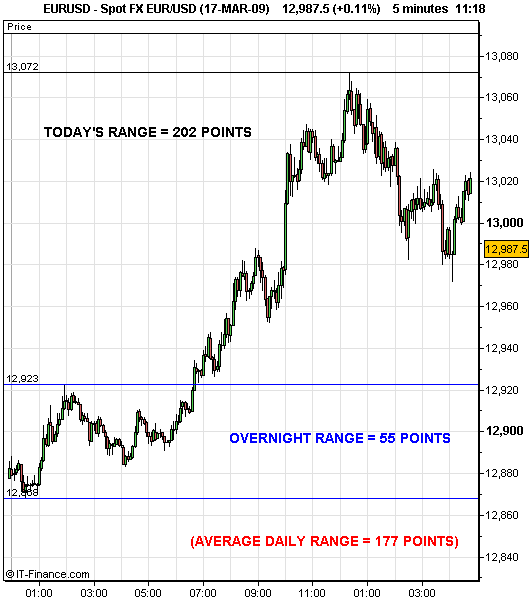Why Trade Intraday Breakouts?
If you watch some of the major currency pairs on a regular basis, you will have noticed that many of these pairs will trade in a directionless sideways trading range at some point during the day, before breaking strongly upwards or downwards.
Therefore you can potentially make some decent profits by waiting for the price to break out of these narrow trading ranges, and opening a long or a short position in the same direction as this breakout.
Breakout trading is generally easier when you lengthen the time frame and use 1-hour, 4-hour or daily charts because the price moves are a lot bigger and you won’t get stopped out as often.
However it is still possible to be successful trading intraday breakouts on the 5, 10 or 15-minute charts, for example, particularly if you do these two things:
Trade Early
You will generally find that the largest intraday price breakouts occur relatively early each day. This is particularly true with the GBP and Euro pairs, for example, because the price generally trades in a tight trading range during the overnight trading session (approx. 00.00 – 6.00) before exploding into life when the London and European markets open (and sometimes an hour or two before they open).
Therefore it is worth watching the overnight trading action, and waiting for possible breakout opportunities at this time, but only when the overnight range is very small compared to the average daily trading range (as shown by the ATR indicator). If the price has already moved quite a lot overnight, it is best to leave this pair alone and look at another one instead.
Not every breakout will be profitable of course. Sometimes the price will break out of the range before reversing in the opposite direction, but the initial breakout will often be significant enough to yield around 10-20 pips when you get the perfect set-up, which may only occur a few times per week across the major currency pairs.
Scale Out Of Winning Trades
Another key to success is to scale out of your winning breakout trades in a two-step process. While you can be profitable setting your exit point 10-20 points higher than your entry point, it is generally more profitable to close half your position at a pre-determined level, maybe 6-10 points higher than your entry point, and then move your stop loss up to break-even, letting the other half run for as long as possible.
This will help to protect your capital if the breakout quickly runs out of momentum, and will also enable you to keep your position open for longer and target larger gains where appropriate.
If you are trading these breakouts at the start of the trading session, as recommended above, and are trading breakouts from a narrow overnight trading range, then it makes sense to bank a profit early on with half the position, move your stop loss up to break-even as soon as possible and then target as many points as possible with the remaining half because there is still plenty of time left for the price to continue trending higher or lower.
Closing Comments
As with any intraday trading strategy, you need to use a broker that provides tight spreads on the major pairs because if not, these spreads will really eat into your profits over time and affect your overall profitability.
It is also a good idea to trade these breakouts early on in the day and only trade the very best set-ups where there is a small overnight trading range (ideally less than 33% of the average daily range). If you use sensible stop losses, and try to move your stop loss to break-even as soon as you are in profit, then it is definitely possible to make money trading these intraday price breakouts.
Finally, it is worth mentioning that this early morning breakout strategy will not be as profitable in the summer months or any other times when volatility is a lot lower, which is why I haven’t found too many good set-ups in the last few months.
However as demonstrated by this breakout example that I posted online back in 2009 when volatility on the EUR/USD was a lot higher, this early morning breakout strategy can yield some big profits when market conditions are a lot more favorable:


Leave a Reply